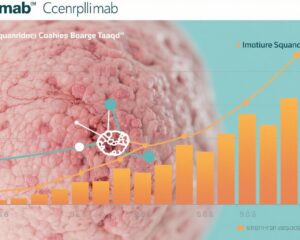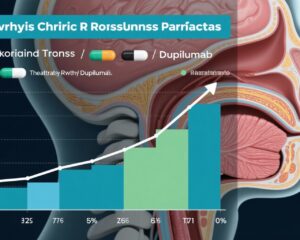Highlights
- Approximately 47% of patients who developed a rash after penicillin treatment during an Epstein-Barr virus (EBV) infection show persistent drug hypersensitivity evidenced by positive intradermal and patch testing.
- Reexposure to penicillin in affected patients may induce recurrent hypersensitivity reactions, including severe cutaneous adverse reactions such as acute generalized exanthematous pustulosis.
- Rashes associated with penicillin use during EBV infection often last 7 days or longer, and skin test evaluations performed a median of 16 months after the initial reaction reveal durable sensitization.
- Clinicians should exercise caution in prematurely labeling patients as penicillin-allergic solely based on clinical rash during EBV infection, underscoring the need for thorough allergy workup.
Background
Epstein-Barr virus (EBV) infection, commonly manifesting as infectious mononucleosis, frequently presents with symptoms resembling bacterial infections, leading to the empirical use of antibiotics such as penicillin. A hallmark clinical feature when penicillin is administered during EBV infection is the appearance of a characteristic maculopapular rash. Traditionally, this rash has been construed as a self-limiting exanthem attributable to the viral illness or transient drug sensitization without long-lasting allergy. However, the long-term persistence of penicillin hypersensitivity in this context remains ambiguous but clinically consequential due to implications for future antibiotic use and patient safety.
Key Content
Clinical and Immunological Evidence of Persistent Drug Hypersensitivity
The study by Cao and Joerg (2025) retrospectively analyzed 15 patients who developed rashes after taking penicillin during acute EBV infection. Patients underwent detailed allergy testing including intradermal skin tests at 48 hours and patch tests at 48 and 72 hours, targeting penicillin derivatives (amoxicillin, ampicillin, penicillin G) and cefuroxime to evaluate cross-reactivity. Median age at rash onset was 18.5 years with a predominance of female patients (86.7%).
Skin test positivity was found in 46.7% of patients, indicating persistent drug sensitization well beyond the viral illness. Importantly, five patients had concordant positive results on both intradermal and patch tests, consolidating evidence for a delayed-type hypersensitivity mechanism. The median elapsed time from rash to allergy testing was 16 months (IQR: 4.3–111 months), underscoring longevity of immune memory against penicillin.
Re-Exposure Risks and Clinical Course
Among four patients who were re-challenged or re-exposed to penicillin-containing antibiotics prior to allergy evaluation, three developed recurrent hypersensitivity reactions. Clinical manifestations ranged from recurrence of maculopapular rash to severe acute generalized exanthematous pustulosis (AGEP), a potentially life-threatening cutaneous adverse drug reaction characterized by pustular eruptions and fever.
Of note, two-thirds of all patients had rashes lasting 7 days or longer, indicating a robust immune activation rather than a mild, transient dermatologic event. These clinical features buttress the argument for persistent immune sensitization rather than fleeting viral exanthem.
Pathophysiological Considerations
The pathogenesis of penicillin-induced skin rashes during EBV infection is likely multifactorial. Viral infection may prime or dysregulate immune responses, promoting aberrant presentation of penicillin-related antigens to T cells. This can result in expansion of drug-specific memory T cells, manifesting as delayed hypersensitivity reactions, which persist beyond acute infection. The positive intradermal and patch tests indicate a T-cell mediated delayed-type hypersensitivity mechanism rather than immediate IgE-mediated allergy. Such immunological memory can trigger vigorous responses upon re-exposure.
Implications for Clinical Practice and Allergy Testing
The classical view that penicillin-related rash during EBV infection is purely a transient, non-allergic reaction must be reconsidered in light of this emerging evidence. Premature labeling of patients as either penicillin-allergic or non-allergic solely on the basis of rash occurrence during EBV may lead to inappropriate antibiotic avoidance or dangerous re-exposures.
Skin testing, including intradermal and patch tests read over multiple time points (48 and 72 hours), remains critical in distinguishing true persistent hypersensitivity. Testing panels should include various penicillin derivatives and cephalosporins to evaluate cross-reactivity and guide safe antibiotic selection.
The substantial proportion of patients demonstrating persistent sensitization necessitates personalized allergy assessment and cautious antibiotic stewardship. Referral to allergists/immunologists for comprehensive evaluation is recommended, particularly prior to any penicillin re-administration.
Expert Commentary
These findings challenge the entrenched dogma that maculopapular rashes during EBV infections treated with penicillin are always benign and transient. Instead, they reveal that nearly half of affected adolescents and adults develop a durable T-cell mediated drug allergy. Such persistent hypersensitivity places these patients at risk for severe cutaneous adverse reactions upon re-exposure.
Guideline frameworks, including those from allergy societies and infectious disease experts, may need to update recommendations to incorporate careful allergy evaluation for patients with EBV-associated penicillin rashes before future antibiotic prescribing decisions.
Further research is warranted to elucidate precise immunological mechanisms by profiling memory T cell subsets, cytokine milieu, and potential viral contributions to immune dysregulation. Prospective, larger cohort studies could validate these findings and refine risk stratification models.
Conclusion
Penicillin-associated rashes in the setting of EBV infection should not be reflexively dismissed as non-allergic or transient. Clinicians must be vigilant to the substantial risk of persistent drug hypersensitivity, documented by positive delayed-type skin testing months after the initial rash. Careful evaluation including intradermal and patch tests is essential to prevent harmful re-exposures and optimize antibiotic use.
This nuanced understanding underscores the necessity of evidence-based allergy workup in patients with EBV-related rashes receiving penicillins, reshaping clinical decision-making and patient safety paradigms in infectious mononucleosis management.
References
- Cao LM, Joerg L. Penicillin treatment in infectious mononucleosis may lead to persistent drug allergy in adolescents and adults even after years. Int Arch Allergy Immunol. 2025 Aug 13:1-7. doi: 10.1159/000547238. Epub ahead of print. PMID: 40815123.


